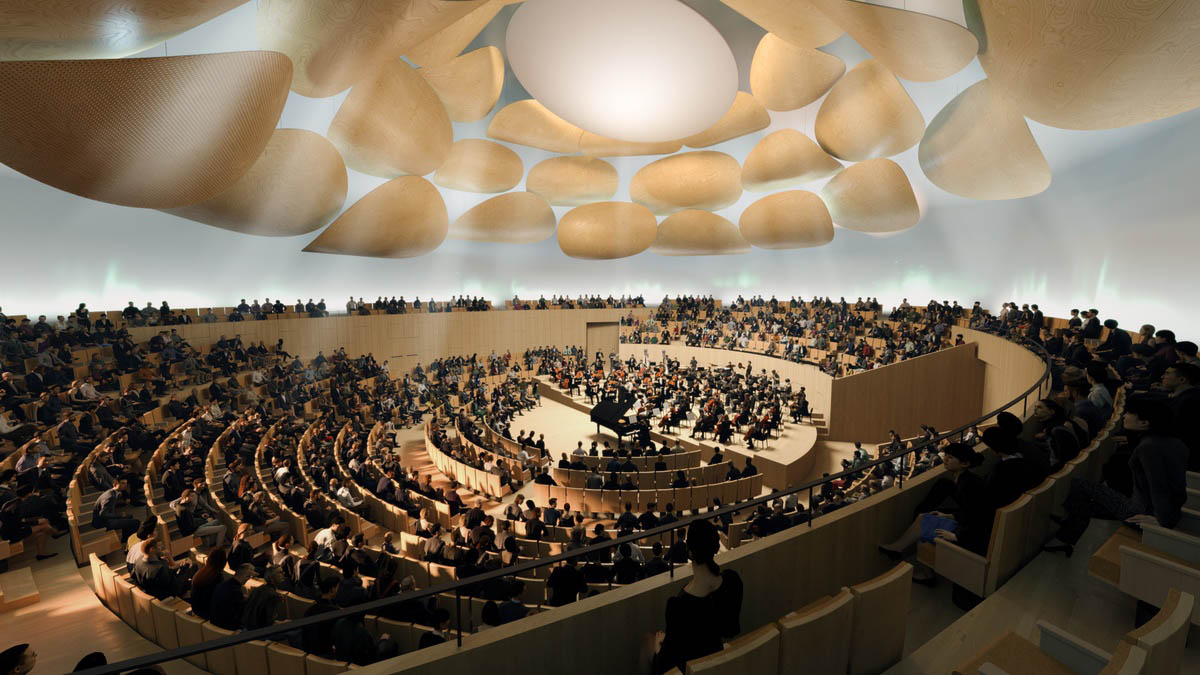Submitted by
OPEN Architecture Reveals "Partially Floating" Yichang Grand Theater Overlooking Yangtze River
teaser2-1--2--3--4--5--6--7--8--9--10--11--12--13--14--15--16--17--18--19--20--21--22--23--24--25--26--27--28--29--30--31--32-.jpg Architecture News - Apr 17, 2023 - 09:51 2034 views

Chinese architecture practice OPEN Architecture has revealed the design for a partially floating theater overlooking the Yangtze River in China.
Called Yichang Grand Theater, the 70,000-square-metre building draws an amorphous shape evoking "an ever-changing body of water".
Taking cues from the the spirit of water in the city, various elements apart from water ripples, mountain ranges, or clouds and mist are trying to define the building around movement.
The building is located on the tip of the Pinghu Peninsula where the Yangtze River and its tributary Huangbai River meet.

Bird's-eye View
Shaped as a fluid and partially floating building, the performing arts center consists of a 1600-seat grand theater, a 1200-seat concert hall, a 400-seat black box, and two outdoor theaters — one on the rooftop and one by the water.
Alongside the performance spaces, the building also includes educational facilities, event and exhibition spaces, rehearsal rooms, coffee shops, restaurants, and observation decks.

Birds Eye View
"The mixed program reflects efforts in making the grand theater an open and vibrant public place at all times," said OPEN Architecture.
Drawing inspiration from "water in ever-changing form", as described by the studio, the building features different perspectives to reveal different forms.
"The design of the grand theater draws inspiration from the spirit of water that defines the city of Yichang," said OPEN’s founding partner, Mr. Li Hu.
"Water may seem soft yet it can have infinite strength—just read the gorges carved by the mighty river. Water is the soul of this unique city," Hu added.

Concert Hall Interior
The building aims to sense and capture the energy of the site, and thanks to its fluid form, the building fosters connections and interactions with various elements such as internal organizations, environmental conditions, and public spaces weaving in and out, above and below, all together forming a state of balance and inclusiveness.
Considering the backdrop of the Yangtze River Conservation Plan and the global climate crisis, the studio has examined the site carefully and thought the grand theater required a particularly sensitive response to the natural conditions surrounding the site.

Concert Hall Lobby
"This is a very rare opportunity that allows us to repair and restore the previously human-damaged site through new construction, and re-establish a balanced, sustainable relationship between nature and the built environment," said OPEN’s founding partner Huang Wenjing.
To cope with the higher groundwater level near the river, the major functional spaces are partially lifted from the ground level, allowing the natural flow from the mountainous inland to the waterfront.

Entrance Platform
According to the studio, elevating the building from the ground greatly reduces the building's footprint and excavation work. Visitors can use most of the ground for local vegetation and public activities, leaving the structure free with open spaces with permeable pavement.
The studio integrates various passive and active strategies into the building, contributing to the sustainable development of the peninsula.

Frontal View
The floating theater also provides artists and stage staff with working spaces that are filled with natural light and ventilation, while creating opportunities for artists to interact with the public.

Rooftop Theater
To reveal a striking appearance, the studio employs a punctured openings varying in sizes and shapes, highlighting the building's organic form and richness.
Shaped in curves, the exterior surface of the building is clad in matte anodized aluminum tubes that reflect the subtle interplays of light and shadow throughout the day, while creating an impression of liquid metal.

Ground Floor Plaza
One part of the building that faces inland has a double-layered facade, with an inner layer of simple stacked geometry responding to complex internal functional needs, while an outer layer of aluminum tubes congruent with the whole building.
Another part, facing the river, proposes natural ventilation into the lobby and circulation spaces through cavities in the facade.

Waterfront Theater
The distance between the two layers varies to create diverse in-between spaces, including a large semi-outdoor garden and cascading terraced gardens, which help to regulate the building's microclimate.
According to the studio, the building takes advantage of the unique site, as it breathes in its environment.

Grand Theater Interior
The ground-level water theater, the rooftop outdoor theater, and the observation deck at the top are connected via a winding public promenade ascending.

Black Box Theater Interior
The promenade and outdoor public spaces will be open to everyone, bringing a futuristic spectacle and the unique bay scenery to all.
The commissioning client said, "The Yichang Grand Theater will welcome everyone and every walk of life."

Distant View

Grand Theater Lobby

Night view

Location plan

Diagrams

Form diagram

Sustainability diagram
Beijing-based architecture firm OPEN Architecture designed a monolithic open-air concert hall comprised of a layered concrete that gives an organic and rock appearance to capture outside Beijing.
The firm also designed a bibliotheater building that resembles a "blue whale" with its open blue skin dotted with different sizes of openings in Shanghai Qingpu Pinghe International School in China.
Project facts
Design Year: 2022 –
Status: Schematic Design
Client: Yichang Urban Construction Investment and Development Co., Ltd
Program: Grand Theater, Concert Hall, Black Box Theater, Rooftop Theater, Waterfront Theater, Rehearsal Rooms, Exhibition, Art Education, Café, Restaurant, Observation Deck, etc.
Building Area: 70,000 m2
Site Area: 40,000 m2
Location: Yichang, Hubei Province, China
Architecture, Interior and Landscape Design: OPEN Architecture
Principals in Charge: LI Hu, HUANG Wenjing
Project Team: LIU Xiaoyang, SHOU Chengbin, CAO Mengxing, ZHOU Zilin, LIU Xuanyu, XU Jiayue, CHEN Yichao, TAO Weijie, JIA Han, WANG Qirui
Theater Consultant: dUCKS scéno
Structure Engineer: Guy Nordenson and Associates
MEP Engineer: LINK Engineering Consultant
Sustainability and Climate Engineering Consultant: Arup
Façade Consultant: RFR
Acoustic Consultant: JH Theater Architecture Design Consulting Company
All images courtesy of OPEN.
> via OPEN Architecture
